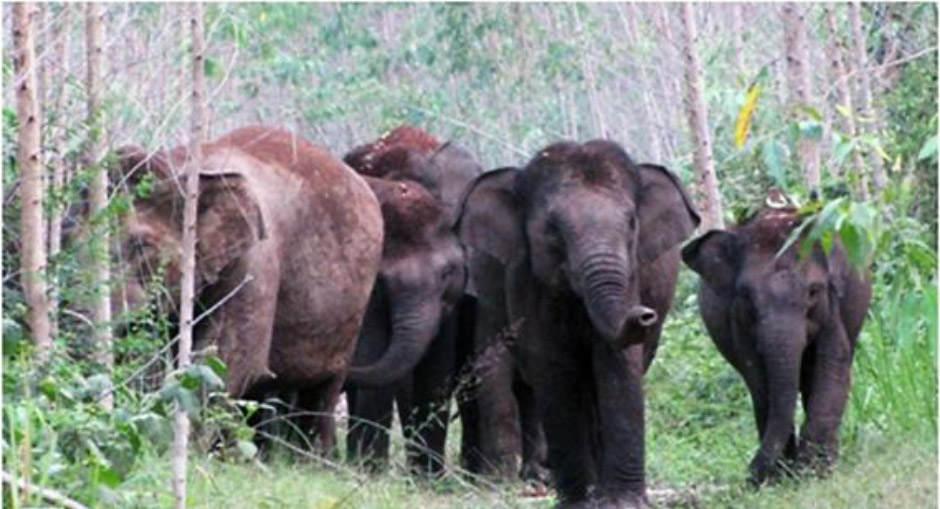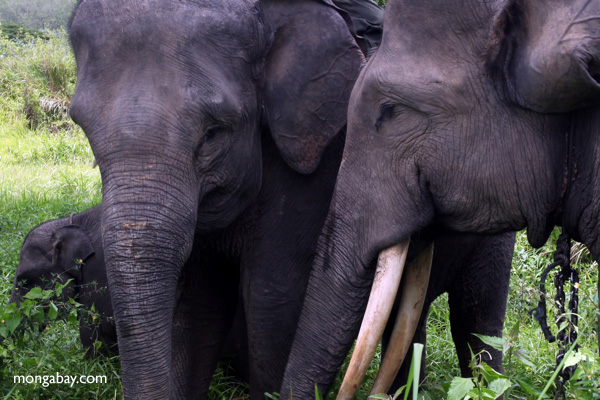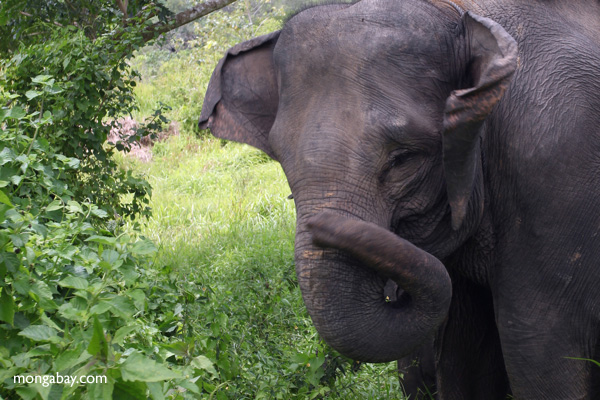- With only roughly 2,800 individuals, the Sumatran elephant (Elephas maximus sumatranus) is critically endangered.
- Population data for Sumatran elephants has been notoriously difficult to gather due to the rarity of sightings and the small size and isolation of the areas in which the elephants live, complicating conservation efforts.
- A new study based on an unusual technique of analyzing DNA in elephant dung provides an assessment of the largest known elephant population in central Sumatra, Indonesia.
Warning: Some images below may contain graphic content.
At best numbering roughly 2,800 individuals, the Sumatran elephant (Elephas maximus sumatranus) is critically endangered. Yet population data has been notoriously difficult to gather due to the rarity of sightings and the small size and isolation of the areas in which the elephants live, complicating conservation efforts. A new study based on an unusual technique of analyzing DNA in elephant dung provides an assessment of the largest known elephant population in central Sumatra, Indonesia, that of the Bukit Tigapuluh landscape.
The new study, published in mongabay.com’s journal Tropical Conservation Science, is part of an island-wide effort to establish basic elephant population data to help with conservation planning. Most previous Sumatran elephant population estimates for Bukit Tigapuluh are outdated or unreliable, underscoring the need for a new assessment, the authors write.

“Certainly, information alone cannot save elephants from extinction, but national and local conservation strategies based on incomplete and/or outdated data would likely fail as scarce conservation resources would not be adequately allocated and important conservation needs and opportunities may be overlooked,” the study states.
The researchers gathered fresh elephant dung from sampling blocks established in two 900-square-kilometer survey areas that they believe all the area’s elephants pass through. By analyzing DNA from the dung samples “using methods similar to those applied in human forensics,” the authors write that in most cases they were able to determine the sex and individual identity of the elephant that left each sample. According to the study, this method has previously been successful in measuring elephant populations in mainland Asia and Africa. The researchers were also able to determine an elephant’s rough age by the size of its dung.
From these analyses, the researchers identified two genetically and geographically distinct subpopulations of Sumatran elephant within Bukit Tigapuluh, one in the Sumai area with 99 animals and the other in the RiauJambi area with 44. Those results are generally consistent with a 2009 study based on a simple count of elephant dung in roughly the same two areas. (The authors deemed that study to be reliable, albeit less precise than their own.)

The new study revealed that the Bukit Tigapuluh landscape has a very low population density of elephants. For example, the RiauJambi area contained 0.05 elephants per square kilometer — sparse for Sumatra, where the mean elephant population density is around 0.15 elephants per square kilometer.
Typically, Sumatran elephant subpopulations have a high proportion of elderly elephants, due to the animals’ longevity. In RiauJambi, however, the researchers observed equal proportions of all age groups, and in Sumai elephants younger than 15 years were the clear majority. This isn’t necessarily evidence of a baby boom, however. “A young population might not necessarily mean recovery, but instead could be a sign of substantial losses in older age classes, as we suspect to be the case for the Bukit Tigapuluh region,” the study states.

Molecular sexing of the DNA samples revealed interesting numbers as well. Elephant populations usually have an even birth rate of both males and females but in Bukit Tigapuluh there were twice as many male calves as female calves. Moreover, older age groups were skewed strongly in the opposite direction, with the study detecting a majority of females and only three adult males in the entire region. The study suggests that the decline in the number of older elephants, particularly bulls, could be indicative of illegal killings.
Despite how few Sumatran elephants remain in the Bukit Tigapuluh landscape, the area is “one of the most important areas for their conservation in Indonesia,” the authors write. After Bukit Tigapuluh, only one other region in central Sumatra — the Tesso Nilo landscape in Riau province — is thought to have a population of 100 or more elephants, making the protection of Bukit Tigapuluh all the more urgent.
The study identifies two main hindrances to the conservation of elephants in Bukit Tigapuluh: the isolation of the two subpopulations increases the risk of inbreeding and the skewed age and sex demographics compromise the ability of the population to thrive.

According to the study, one serious conservation challenge elephants face in Bukit Tigapuluh is illegal killing by people for ivory and as a result of conflict over crop raiding by the elephants. The authors note that “it is unlikely that the extreme distortions observed in our study could have been caused solely by chance or natural difference in mortality.” A Forest Police investigation documented 17 elephants killed by humans between 2008 and 2014.
However, loss of habitat is the biggest threat to elephants, the study asserts. “The critically endangered status of the Sumatran elephant is primarily due to massive habitat destruction, which has resulted in the local extinction of the species in at least 15 areas,” the authors write. In Bukit Tigapuluh, much of the original forest has given way to private farmland, coal mines, rubber tree plantations, pulpwood plantations, and former logging areas, resulting in a patchy habitat that contributes to the isolation of elephant subpopulations.

The study closes with some suggested conservation strategies. To reduce inbreeding, the authors recommend increasing the permeability of the geographic barrier between the two subpopulations and bringing in individuals from outside populations. Preventing the killing of the elephants is a clear priority, and the study suggests that stricter law enforcement will be needed. “In spite of a long history of illegal elephant killings in Bukit Tigapuluh … convictions are extremely rare, and improvements to investigations and legal proceedings are likely required,” it states.
As for the conservation of elephant habitat, the authors write, “[t]he coexistence of elephants and humans on intensively used agriculture land may not be possible, but extensive productive forest concessions surrounding the Bukit Tigapuluh National Park provide potentially safe habitat,” where “wildlife-friendly management…could transform much of the landscape into suitable elephant habitat.”



Citations
- Moßbrucker, A.M., Apriyana, I., Fickel, J., Imron, M.I., Pudyatmoko, S., Sumardi, and Suryadi, H. (2015). Non-invasive genotyping of Sumatran elephants: implications for conservation. Tropical Conservation Science 8(3): 745-759. Available online: http://www.tropicalconservationscience.org/
